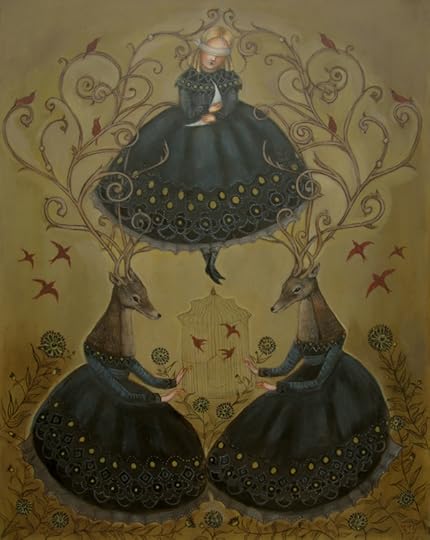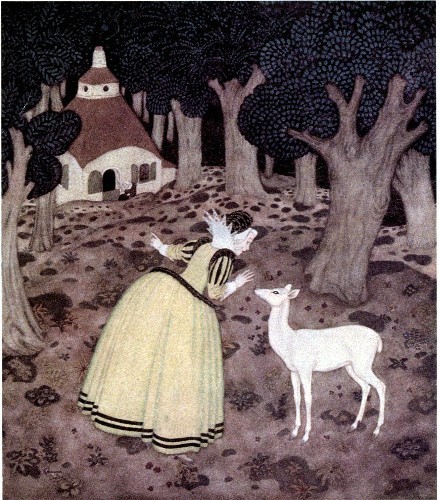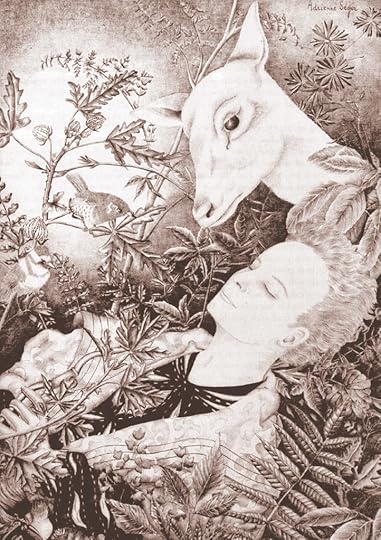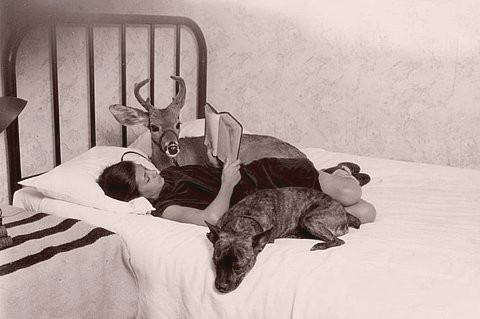Into the Woods, 18: Following the Deer (Part I)
"As long as people have lived or hunted alongside the deer's habitats," says writer and mythographer Ari Berk (in "Where the White Stag Runs"),
"there have been stories: some of kindly creatures who become the wives
of mortals; or of lost children changed into deer for a time, reminding
their kin to honor the relationship with the Deer People, their close
neighbors. And there are darker tales, recalling strange journeys into
the Otherworld, abductions, and dangerous transformations that don't end
well at all. But all stories about the deer share some common ground by
showing us that the line between our world and theirs is very thin
indeed."
Ovid's Metamorphoses, Ari continues, tells the story "of youthful Actaeon who
spends the day hunting with his dogs on the hillsides, catching so much
game that the slopes run red with blood. As the sun ascends the sky, he
calls off the chase, bidding his comrades retire with the promise of
renewing the hunt early the next day. Then he does a dangerous thing: he
wanders for a time in a wood he does not know, and so comes by accident
to the sacred grotto where Diana is accustomed to bathe with her
nymphs. To Actaeon's great misfortune, he spies the goddess of the hunt
naked and she, seeing him, blushes.
Then lifting up her hands, she throws water in Actaeon's face and he
flees that place. As he wanders back to find his friends he hears his
dogs barking and sees that they are chasing him. Confused he calls out
to them, but instead of his voice, he hears the bellowing of a great
stag, for stag he now is, transformed by the goddess's vengeful hand. So
he runs fast on four legs but soon his dogs chase him down and, tearing
him apart, find their old master toothsome indeed. The myth of Actaeon is an early example of the connection of deer
stories with the violation of taboos. Actaeon made three fatal errors:
overhunting the hillside, entering a sacred enclosure unknowingly, and
gazing upon the virgin mistress of the hunt. His punishment is perfectly
suited to address his errors for he learns to see the world, though
briefly, from the perspective of a shy creature who calls the wild home
and instinctively respects its boundaries.
"In the medieval Welsh Mabinogion, does and stags appear as
physical manifestations of the boundary between worlds. In the story of 'Pwyll,' the deer are followed into the forest during a hunt. But Pwyll,
the prince, and his dogs are soon separated from his companions and he
finds himself lost in the woods. Soon he hears other dogs and,
following their barking, comes upon a clearing in the woods where he
finds a strange pack—red-eared and white-furred—bearing down upon a
stag. Pwyll chases those dogs off and sets his own upon the stag
instead, most discourteously. When he later meets the owner of the
white dogs—who is none other than the Arawn, lord of the
Otherworld—satisfaction is demanded and Pwyll must repay Arawn by
assuming his form and exchanging places, traveling into the Otherworld
to kill one of Arawn's enemies. So following the deer is often a way
into the Otherworld, or a sign that we are very close to its borders."
as crows fly
in the dawn light
on the cold hill
the deer are running
the thud of their hooves
on the bed of the stream
is the drum that rocks
the roots of the birch
and the wind that shakes
the birch tree’s leaves
- Scottish poet Chris Powici (from "Deer")
Deer that roam the Western fairy tale tradition are guardians, guides, companions to the fairies, and occasionally fairies themselves in disguise -- or else they are men and women be-spelled, roaming the woods in animal-shape by day, briefly regaining their humanity each night. In Brother and Sister from Grimms' Fairy Tales, for example, two siblings flee their wicked stepmother through a
dark and fearsome forest. The path of escape lies across three
streams, and at each crossing the brother stops, intending to drink.
Each time his sister warns him away, but the third time he cannot
resist. He bends down to the water in the shape of a man and rises
again in the shape of a stag. Thereafter, the sister and her
brother-stag must live in a lonely hut in the woods . . . but
eventually, with
his sister’s help, (and after she marries a king), the young man resumes his true shape.
Ellen Steiber looked at this tale's archetypal patterns when writing her contemporary version, "In the Night Country" (published in The Armless Maiden). "Fairy tales are journey stories," she says in a beautiful essay on the subject. "They deal with initiation and
transformation, with going into the forest where one's deepest fears and
most powerful dreams are realized. Many of them offer a map for getting
through to the other side. Out of curiosity, I went back to the
patterns of three in [Brother and Sister], since the very rhythms of repetition set
them off and give them importance. There are three brooks, three days of
the hunt, and three times that the queen's ghost speaks [after the sister's marriage to the king, when her role as queen has been usurped by her step-sister]. Each of these
patterns presents challenge and transformation;
they are the places of power in the story, the points where true magic
occurs. In the first the brother is thirsty; he needs nourishment and
finally gets it, a difficult metamorphosis being the price. In the
second he must either follow his own deer nature or 'die of grief'; at great
risk he runs with the hunt, and that act takes both brother and sister
farther along on the path they must travel to a new state of being.
(It's worth noting that in the fairy tales one can rarely remain in the
forest — one takes what was found there and brings it back into the
world.)
In the third challenge, the king must recognize the [true] queen, an act that
will restore her to life and lead to a redress of wrongs, a final ending
of the curse, a coming into balance. As abuse [in a family] takes many forms, so does
salvation. Here are three of many acts that can get you through:
nourishing yourself, following your heart even at great risk, and being
seen for what you are."
Beloved, what can be, what was,
will be taken from us.
I have disappointed.
I am sorry. I knew no better.
A root seeks water.
Tenderness only breaks open the earth.
This morning, out the window,
the deer stood like a blessing, then vanished.”
- American poet and essayist Jane Hirshfield (from "Standing Deer")
In The
White Deer (a.k.a. The White Hind and The White Doe), from the French fairy tales of Madame d’Aulnoy,
a princess is cursed in infancy by a fairy who'd been insulted by her
parents. Disaster will strike, says the fairy, if the princess
sees the sun before her wedding day. Many years later, as she travels
to her wedding, a ray of sun penetrates her carriage. The princess
turns into a deer, jumps through the window, and disappears into the forest -- where she's eventually hunted by her own fiancé, who does not know what she has become.
As she flees the arrows of the royal hunting party, the prince is as "unescapable as memory" in this passage from Eve Sweetser's poem, "The White Hind at Bay":
She leads him through briars, bogs
scent-killing brooks — inexorably
the following fate comes on.
Always, till now, some twist has let her out.
In exhaulted desperation
she sees the cliff before her.
From teeth and knives
her white hide is no protection
"Leave off these fawnish fantasies,
her kind deer parents often said
"What's a white skin?
Does every third-born son
wed a princess?"
Can wild hope save her?
Can she be again
the princess she was in childhood
(or was it dreamed of?)
exquisite and beloved,
ideal and human both?
It is so far — so long ago
she left off thinking of glass slippers
accepted her four hooves.
two deer
came walking down the hill
and when they saw me
they said to each other, okay,
this one is okay,
let’s see who she is
and why she is sitting
on the ground like that,
so quiet, as if
asleep, or in a dream,
but, anyway, harmless;
and so they came
on their slender legs
and gazed upon me
not unlike the way
I go out to the dunes and look
and look and look
into the faces of the flowers;
and then one of them leaned forward
and nuzzled my hand, and what can my life
bring to me that could exceed
that brief moment?
- American poet Mary Oliver (from "The Place I Want to Get Back To")
"Deer is a common figure in American Indian myths, " notes Ari Berk, "often appearing
in stories that continue the focus on families, kinship, marriage,
child-rearing, hunting and pursuit. Among the Pueblos of the New Mexico,
stories are still told of Deer Boy, a baby left in the grass, abandoned
by its young mother, a girl of the village. It was a Deer Woman who
found the human child and brought him home to raise with her own fawns.
Time passed and the boy spent the days running with his fawn brothers
and sisters. Some time later, a hunter from the village noticed strange
tracks among those left by the Deer People. The Deer Woman knew the time
had come for the boy to return to his people. She readied him to be
caught by the hunter and told him what he must know about his real
mother and what she looked like. She told him that to remain among his
own people he must, upon returning to the village, be left alone and
unseen in a room for four days. So he was found by the hunter and taken
home and much happiness attended his homecoming. The boy told his family
he must be left alone for four days and they agreed. But his birth
mother, so impatient was she, stole a glance at her son before the four
days were finished. In an instant the boy took on the shape of a deer
and ran to the North where he joined his other mother and lived for the
rest of his days among the Deer People."
The Yaqui (Yoeme) people of the Sonoran desert traditionally divide themselves into
two related groups: the Vato'im (Baptized Ones), who remain in this
world and integrate seventeenth century Spanish Catholicism with the
rites of their own aboriginal religion, and the Surem (the Enchanted
People), who went away to the Wilderness World to preserve the ancient
ways. In the extraordinary Deer Dance, still performed at Easter and
other times in Arizona and northern Mexico, a dancer takes on the shape,
the movements, the consciousness of the sacred deer on the borderline
between these two worlds, blessing the ground he walks on. Yaqui Deer Songs
by Larry Evers and Felipe S. Molina is a beautiful account of a deer mythology that is not buried in history but still living,
still a vibrant part of everyday life for the modern Yoeme.
"Flower-cover fawn went out, enchanted, from each enchanted flower
wilderness world, he went out...," the singers sing as the deer dancer
moves, gourd rattles in his hands and strings of rattles bound around
his shins. A deer head rises over his own, antlers decorated with
flowers. "So this now is the deer person, so he is the deer person,
so he is the real deer person...." The drummers drum, the dancer
leaps, and it is the real deer person indeed.
Question: Can you tell us about what he is wearing?
Well, the hooves represent the deer’s hooves,
the red scarf represents the flowers from which he ate,
the shawl is for skin.
The cocoons make the sound of the deer walking on leaves and grass.
Listen.
Question: What is that he is beating on?
It’s a gourd drum. The drum represents the heartbeat of the deer.
Listen.
When the drum beats, it brings the deer to life.
We believe the water the drum sits in is holy. It is life.
Go ahead, touch it.
Bless yourself with it.
It is holy. You are safe now.
- Tohono O'Odham author Ofelia Zepeda (from "Deer Dance Exhibition")
Native American writer and educator Carolyn Dunn describes the Deer Woman tales she grew up with in a short, poetic essay on the subject:
"Deer Woman's specific magic and myth surrounds marriage and courtship
rituals," she says. "I write of Deer Woman from the
Cherokee/Muskogee/Seminole/Choctaw perspective because this is what I
know. But other cultures have encounters with Deer Woman or Deer Man.
Ella Cara Deloria recorded several traditional Dakota and Lakota
narratives which mirrored the Southeastern tribes' Deer Woman stories.
The Karuk, according to the Karuk artist and storyteller Lyn Risling,
have stories of the Deer Woman in which the spirit is associated with
fertility and maturation rituals and prepares young women for marriage.
The Southeastern stories are similar in that young people must be
instructed in the choosing of a societally-approved mate in order for
cultural survival and regeneration.
In these stories, a beautiful young woman meets a young man and
entrances him into a sexual relationship. The woman is so beautiful that
the young man is often swayed by her beauty away from family, home,
community. If the young man is so entranced as to not notice the young
woman's feet—which in the case of Deer Woman are hooves—then he falls
under her spell and stays with her forever, wasting away into
depression, despair, prostitution, and ultimately, death.
"The Deer Woman spirit teaches us that marriage and family life
within the community are important and these relationships cannot be
entered into lightly. Her tales are morality narratives: she teaches us
that the misuse of sexual power is a transgression that will end in
madness and death. The only way to save oneself from the magic of Deer
Woman is to look to her feet, see her hooves, and recognize her for what
she is. To know the story and act appropriately is to save oneself from a
lifetime lived in pain and sorrow; to ignore the story is to continue
in the death dance with Deer Woman. Deer Woman instructs us that sexual
attraction does not a proper marriage make; it is the societal and
cultural responsibility of each tribal member to choose a mate
wisely—therefore ensuring tribal survival into the next generation. Both
the Karuk stories and the Southeastern stories illustrate this cultural
responsibility."
Navajo author and musician Joy Harjo finds Deer Woman in a bar late on a winter's night in her haunting prose-poem "Deer Dancer":
"She was the myth slipped down through dreamtime. The promise of feast we
all knew was coming. The deer who crossed through knots of a curse to find
us. She was no slouch, and neither were we, watching.
"The music ended. And so does the story. I wasn't there. But I imagined her
like this, not a stained red dress with tape on her heels but the deer who
entered our dream in white dawn, breathed mist into pine trees, her fawn a
blessing of meat, the ancestors who never left."
Chickasaw writer Linda Hogan addresses the secret desire so many of us have to run away with the deer ourselves in this passage from her beautiful poem "Deer Dance":
That night, after everything human was resolved,
a young man, the chosen, became the deer.
In the white skin of its ancestors,
wearing the head of the deer
above the human head
with flowers in his antlers, he danced,
beautiful and tireless, until he was more than human,
until he, too, was deer.
Of all those who were transformed into animals,
the travelers Circe turned into pigs,
the woman who became the bear,
the girl who always remained the child of wolves,
none of them wanted to go back
to being human. And I would do it, too, leave off being human
and become what it was that slept outside my door last night,
rested in my sleep.
"Convince the deer you are one of
them," advises Shauna Osborne, a Comanche/German mestiza writer from New Mexico. "Dance with them and they will show you the way. Pay strict attention to
the leg positions and neck angles—that’s where the heart of their dance lies. Deer
have this natural grace, this presence, on the dance floor that just can't be
beat. Once you find it, you’ll know. Do some research: Ginger Rogers had a
definite tinge of deer blood in her and my mother always swore that Travolta
had to be part deer. "How else could he glide through the air like
that?" she would demand. However,
the best contemporary example of a deer dancer has to be, without doubt,
Christopher Walken. He defies the laws of physics with such style and does it
with a nonchalant matter-of-factness which all deer dancers should try to
emulate. Treat his work as it should be treated—a sacred text of the Deer
Dancers. Roll with this or roll with that—just make sure your feet never quite
touch the ground. However, you must remember: when the song ends, the story
does too."
The enchanted deer imagery above is: Winged deer in a pattern from a medieval French tapestry; "Diana (Artemis) and Acteon" by Domenico Veneziano (1410-1461); "The Mystic Wood" and "The Lady Clare" by John William Waterhouse (1849-1917); "Running Deer" by Alex Herbert, "Brother and Sister" (the cover image for an edition of Grimms Fairy Tales) by John Barton Gruelle (1880-1938); “Brother and Sister” by Carl Offterdinger (1829-1889); "Perched" by Kelly Louise Judd; "Brother and Sister" by Edmund Dulac (1882-1953); "The White Deer" by Adrienne Ségur (1901-1981); "All by Grandmothers" by Kristin Vestgard; an old photograph (provenance unknown); "The Deer Woman" by Susan Seddon Boulet (1941-1997); "Easter Procession, Rancho Camargo, Sonora" (from the "Miners & Mayos" photography series) by David Bacon; "Deer Dancer" portrait by Kyle Bowman; "The Deer Man" and "The Deer Woman" by Wendy Froud; "Deer Maiden" bronze by Erich Schmidt-Kestner (1887-1941); "Born" by Kiki Smith; three deer sketches by Daniel Egnéus; and a deer photograph (provenance unknown).
Terri Windling's Blog
- Terri Windling's profile
- 708 followers

























